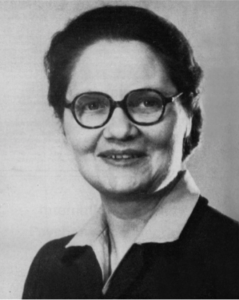 Hilda Bruce devoted much of her life to biological research. Her educational background was indicative of her times. Her terminal degrees were a Bachelor of Science in Household and Social Sciences followed by a Bachelor of Science in Physiology from Kings College for Women (Parkes 1977). Her career started in teaching, but in 1930, she began work at the National Institute for Medical Research (NIMR) in Hamp- stead, England. Her initial work was on vitamin D (eight co-authored articles). She also was one of the first to do research with golden hamsters (Mesocricetus) newly obtained from the Mideast and destined to become a commonly used laboratory rodent. Be- tween 1933 and 1944, she continued work on vitamin D in several laboratories before returning to the NIMR at the request of A.S. Parkes to coordinate work using diverse laboratory animals. Early publications with titles such as “Cereals and Rickets: The Role of Inositolhexaphosphoric Acid” would not lead the reader to suspect a substantive contribution to reproductive biology.
Hilda Bruce devoted much of her life to biological research. Her educational background was indicative of her times. Her terminal degrees were a Bachelor of Science in Household and Social Sciences followed by a Bachelor of Science in Physiology from Kings College for Women (Parkes 1977). Her career started in teaching, but in 1930, she began work at the National Institute for Medical Research (NIMR) in Hamp- stead, England. Her initial work was on vitamin D (eight co-authored articles). She also was one of the first to do research with golden hamsters (Mesocricetus) newly obtained from the Mideast and destined to become a commonly used laboratory rodent. Be- tween 1933 and 1944, she continued work on vitamin D in several laboratories before returning to the NIMR at the request of A.S. Parkes to coordinate work using diverse laboratory animals. Early publications with titles such as “Cereals and Rickets: The Role of Inositolhexaphosphoric Acid” would not lead the reader to suspect a substantive contribution to reproductive biology.
In coordinating breeding colonies of laboratory animals of various species and strains, Bruce knew that issues of sexual dominance, preferences, and differences in breeding systems altered the success of reproductive efforts. She also knew that having a cohort of females at the same stage of gestation would be useful, but to achieve that outcome, females would need to have synchronous periods of estrus. In the 1950s, she began to examine some of these issues. She conducted a series of mating trials with and without oral steroids and noticed that the presence of a new male a day after a female mated with a different male could synchronize estrus in female mice; no steroids needed. When presented with a new male, a female stops the first pregnancy and starts a new one with the new male. Even just the olfactory cues of a new male are sufficient for a female to block implantation. This olfactory block to implantation is now known as the Bruce effect. Her finding “was a major discovery and an out- standing example of disciplined research” (Parkes 1977:2) and brought her the Oliver Bird Medal.
In several sole-author articles, Bruce described the olfactory stimulation of a neuro- response in mice. Additional work by Bruce explored the suckling response of lactation in rats, the role of the thyroid in reproduction, and the effect of current lactation on development of embryos (again in mice). In 1963, Bruce retired from the NIMR, but her research continued as a part-time investigator at the Department of Investigative Medicine at Cambridge until 1973, where she once again focused on nutrition, development, and, of course, pheromones. Her long career occurred when being a woman in the sciences was uncommon, and through that career she substantively advanced the field of reproductive physiology.
Text from Reproduction in Mammals: The Female Perspective, Hayssen and Orr 2017
Photo courtesy of Journal of Reproduction and Fertility, used with permission.